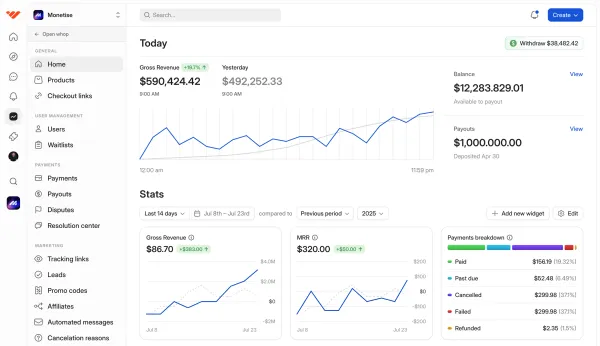Pricing your online coaching offer doesn’t have to be confusing. Read this guide and learn how to charge for your services, attract clients, and get paid what you’re worth.
Key takeaways
- Coaches achieve six-figure income by pricing packages based on results rather than hours worked.
- Package pricing outperforms hourly rates by focusing clients on outcomes instead of session length.
- Tiered pricing structures attract diverse clients while guiding them toward premium coaching options.
- Multiple revenue streams like communities and courses maximize coaching income beyond one-on-one sessions.
- Value-based pricing stops clients from comparing coaches solely on price and emphasizes transformation.
The key to six-figure coaching income is pricing your packages based on results, not hours.
Pricing can make or break your profits: et your rates too high and you’ll scare off clients. Set them too low and you’ll drown in work without ever hitting your income goals.
So how do you find the sweet spot – pricing that attracts the right clients, protects your time, and gets you to six figures (and beyond) without burning out?
That’s exactly what we’ll break down in this guide.
Why pricing matters for online coaching
Getting your pricing strategy right means you aren't undervaluing yourself or losing business.
BTW: There are 167,000+ active coaches worldwide, and getting your pricing strategy right has never been more crucial.
If you’re new to coaching, you might start with lower introductory rates to attract your first sign-ups quickly.
This is penetration pricing: those early clients are gold. Even if they stay on your lower rate, they give your business the traction it needs to grow.
Another approach is competitive pricing, where you match what other coaches charge. It’s a safe move, but it can also limit your potential earnings.
Then there’s value-based pricing. When you focus on the transformation and results your coaching delivers, clients stop comparing you on price alone.
Read next
3 pricing strategies for online coaches
There’s no one-size-fits-all way to price your coaching, but most successful coaches fall into one of 3 camps.
These pricing models help you build structure, set expectations, and grow your income with less guesswork:
1. Package fees
Instead of selling your time by the hour, package your coaching as a productized offer with a fixed rate. Bundling services and content creates clear, valuable offers that clients can easily say yes to.
A sales coach could offer a four-month package with weekly one-on-one sessions plus self-study materials.
You can also tier packages (basic, standard, premium), giving clients a choice while guiding them toward the option you prefer.
Another strategy is perceived savings: price your packages to look like a better deal compared to à la carte sessions or higher-ticket tiers.
On Whop, YenCommerce offers two coaching packages: a one-time payment for group coaching or a subscription for one-on-one guidance.

2. Retainer
Retainers are ideal for building recurring, predictable income. Instead of charging per session, clients pay a fixed monthly fee for ongoing access and support.
You can include a set number of calls, check-ins, or message-based coaching each month, depending on your niche and capacity.
This model works well for long-term client relationships and consistent revenue. Once your roster fills, you can raise rates, add a group tier, or scale by bringing on support.
3. Hourly rates
Charging by the hour is simple: clients pay for the time you spend coaching. This method is easy to calculate and assigns a clear value to your time.
However, hourly pricing has limitations. Clients may focus on session length instead of results, and your income is capped by how many hours you can work.
That said, if you’re an in-demand expert or have limited availability, hourly rates can make sense.
For most coaches, packages or retainers scale better while keeping the focus on outcomes.
Online coaching pricing: 3 real-life examples
Here are three online coaches and their pricing strategies for inspiration:
1. Sean Foley

Golf coach Sean Foley offers a single lesson for $460, as well as a monthly package that includes two online lessons every month for a whopping $690 per month.
As you can see from his Skillest profile, he’s done over 300 lessons, giving him earnings of around six figures from this platform alone.
He’s an example of value-based pricing, with customers coming to him with the perception that they’re going to get ultra-valuable minutes from one of the very best online coaches in the world.
2. Team Bull Trading

Founded by Jdun Trades, Team Bull Trading coaches aspiring traders on how to navigate the markets with confidence.
Team Bull uses tiered pricing (including a free offer) to make their offers more accessible.
Depending on which product they purchase (there's even a free ebook to act as a funnel), mentees get access to 1:1 coaching, daily live trading & screen share with Team Bull’s top traders, private recordings, guest speakers, and access to Team Bull’s community of 5,000+ traders.
With a strong focus on community and practical education, it’s designed to help beginners and experienced traders alike sharpen their skills.
3. Alexis Seleste

Finally, here’s Alexis Seleste, online sales coach and top earner on Whop.
As you can see, she has three coaching offers ranging from low to high tier, giving everyone access to her coaching in some way.
Having tiered pricing is attractive for both newcomers looking to budget and experienced mentees ready to pay more for more intense coaching.
Low vs. high-ticket pricing
Should you go for low-priced, short-term packages or premium, long-term programs?
It depends on the transformation you’re offering and the results your clients expect.
The key is matching package length and price to the client’s goals, not just your comfort level or market trends.
Here’s a quick breakdown:
| Package type | Best for | Example offers |
|---|---|---|
| Short-term, low-cost | Quick wins and fast results | Job search bootcamp, interview prep |
| Long-term, high-cost | Deep, transformational outcomes | Business growth program, wellness coaching |
How you can make more money as an online coach
There are a ton of ways to add to your revenue without too much extra work and while maintaining your online coaching as your flagship business.
Here are a few of them:
Create a members-only coaching community
A community can become a brilliant source of income in many ways, whether premium or free.
Free communities work two-fold: people who join your community often become coaching clients, while premium members alone create a source of passive income for you (and premium also means less work on the moderation front).
Publish a newsletter
Much like with a community, you can go down both the free and premium newsletter route. You might even have an advantage with the latter, since as a coach, your entire thing is to impart knowledge to your clients.
"You can use the Forums app to make announcements to your clients on Whop.
Make sure to turn on email sending, so that every time you make a post, it also gets sent as an email to your users."
- Brett Malinowski, Head of Marketing at Whop
This can be done in snippets for a paid subscriber list, and it’s worth considering since most other types of creators struggle to come up with content that’s worth paying for.
Sell a course
Courses can be an extremely valuable revenue stream since, unlike coaching, you don’t have to be there and doing your thing in order to be paid.
You can create a course and upload it, then sit back (or get busy coaching) while the dough flows in.
And if you don’t want to create a course on your area of specialization? Sell a course on coaching itself!
Host a paid webinar
Paid webinars are one-off events that many people will pay for if you’re able to put up a significant value proposition. They’re a great idea if you want to do a collaboration with another top coach or expert in a specific field.
Publish an ebook
With all of the value you’re giving people on a daily basis as an online coach, it might be possible to distill all of that knowledge down into ebook form.
People who like your book might even hunt you down and be more likely to buy your high ticket coaching options.
I use my following on social media whether it be YouTube or Instagram to drive sales directly to these books."
- Jeremie Lander from Better Finance Today LLC
If you don’t have the time or energy to create an ebook yourself, just work with a ghostwriter. It won’t break the bank, and will be an even more polished, professional product upon release.
All of the above!
To really maximize your online coaching income, create multiple streams of revenue.
At first, you may think that this could be overwhelming as you navigate multiple systems and platforms for your business. But with Whop, you can do it all in one place.
"The old model? A low ticket course funnelling into high ticket coaching. The new model? Skip straight to the money-making infrastructure."
- Hunter Dickinson, Head of Partnerships at Whop
Create your whop (your online hub) and you can create a private community where you host video calls, create a chat channel, sell add-ons like ebooks and online courses, and even send emails using the forums app.
The secret to making six figures as an online coach
Making six figures as an online coach starts with getting the big calls right, especially your pricing and package structure.
Use tiered pricing: lower-cost offers to bring clients in, and high-ticket packages to scale your income.
Then, add extras like paid newsletters, ebooks, or a coaching community to keep clients engaged and create funnels back into your core services.
Consistency pays off, too. The longer you stay in the game, the more referrals you earn, and every blog, video, or social post builds your authority and demand.
Finally, choose the right platform.
One that simplifies your workflow, includes the tools you need, and protects your revenue can make the climb to six figures much faster and less stressful.
Online coach? Make even more money with Whop
If you want to take your online coaching business seriously? Coach on Whop.
It’s free to get started, and payment commissions start at only 2.7% – super low industry fees, especially for an all inclusive platform that lets you expand into other offerings with minimal effort.
1:1 and group video calls, communities, newsletters, apps, a course builder and your own landing page – it’s never been easier to launch an online coaching business.
Sign up to Whop today and launch your online coaching business for free.



